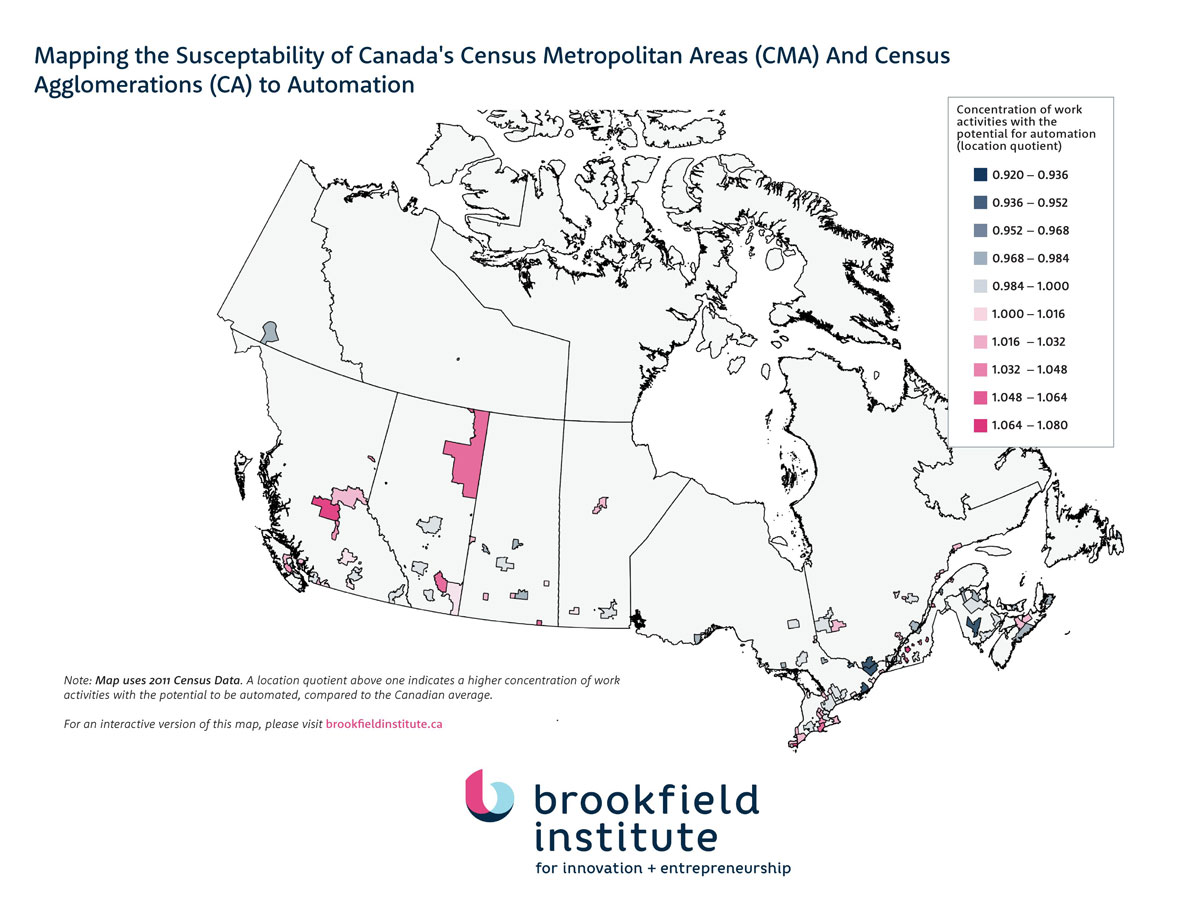Automation Across the Nation: What Rapidly Advancing Technology Means For Canadian Regional Economies

Canada’s complex and varied economy means that the effects of automation will not be evenly distributed across the country, according to a new report entitled Automation Across the Nation: Understanding the potential impacts of technological trends across Canada (external link, opens in new window) from the Brookfield Institute for Innovation + Entrepreneurship (BII+E).
This report provides a new way to understand the regional effects of automation, following BII+E’s highly cited study T (external link) he Talented Mr. Robot: The impact of automation on Canada’s workforce (external link, opens in new window) , which indicates that nearly 42 percent of the Canadian labour force is at risk of being affected by automation in the future.
As technology rapidly advances, it drives economic growth, but simultaneously poses potential risks for workers in industries such as food services, manufacturing, transportation, agriculture, and oil and gas extraction, within which a growing number of tasks can be automated.
The report states that smaller regional economies specializing in mining or manufacturing are most vulnerable to automation. These economies are primarily concentrated in southwestern Ontario, southern Quebec and the Canadian Prairies. Small regional economies with a large hospital, post-secondary institution or public sector presence, however, are less vulnerable. Larger regional economies, like big cities, with diversified economies and large pools of highly skilled labour may also be cushioned from the effects of automation; however, for most, a sizable portion of their labour force is still highly susceptible.
“We expect that the impact of automation will vary considerably across Canada's towns and cities,” said Sean Mullin, Executive Director of BII+E. “By better understanding the geographic distribution of this trend, we believe the country will be much better prepared to weather the risks and reap the potential benefits of automation."
Report Key Findings:
- Small regional economies specializing in manufacturing or mining, quarrying, and oil and gas extraction are most susceptible to automation, including Woodstock, Ont., Tillsonburg, Ont. and Quesnel, B.C.
- Areas less susceptible to automation include cities and towns with a large hospital, post-secondary institution or public sector presence, for example, Petawawa, Ont., Ottawa-Gatineau, Ont., and Fredericton, N.B.
- Industries with the highest proportion of automatable work activities include: accommodation and food services; manufacturing; transportation and warehousing; agriculture, forestry, fishing and hunting; and mining, quarrying, and oil and gas extraction. About 62 percent of work activities could be automated within these industries.
- Applied to 2011 Canadian census data, about 46 percent of work activities have the potential to be automated, across all Canadian industries. However, this does not mean that 46 percent of jobs could be automated as most jobs are comprised of a mix of work activities, only some of which are automatable. The proportion of work activities that could be automated is significant - equivalent to about 7.7 million jobs across the country.
- Even Canada’s largest cities are not immune to the effects of automation; in Toronto, Montreal and Vancouver, about 46 percent of work activities have the potential for automation.
- The diversity of a local economy, which varies across Canadian cities and towns, can influence the potential impacts of automation. Highly specialized cities and towns in which a high proportion of work activities have the potential to be automated may be the most vulnerable.
Also included as part of the report is a data visualization map (external link, opens in new window) , which shows the susceptibility of Canadian cities and towns to automation impacts.
The findings contained within Automation Across the Nation: Understanding the potential impacts of technological trends across Canada (external link, opens in new window) (external link) are based on data from management consulting firm, McKinsey & Company, mapped against local employment data from Statistics Canada’s National Household Survey.
The Brookfield Institute for Innovation + Entrepreneurship (BII+E) is a new, independent and nonpartisan institute, housed within Ryerson University, that is dedicated to making Canada the best country in the world to be an innovator or an entrepreneur. BII+E supports this mission in three ways: insightful research and analysis; testing, piloting and prototyping projects; which informs BII+E’s leadership and advocacy on behalf of innovation and entrepreneurship across the country. For more information, visit brookfieldinstitute.ca (external link, opens in new window) .
Ryerson University is Canada's leader in innovative, career-oriented education. Urban, culturally diverse and inclusive, the university is home to more than 44,500 students, including 2,400 master's and PhD students, 3,200 faculty and staff, and nearly 170,000 alumni worldwide. For more information, visit https://www.torontomu.ca (opens in new window) .
- 30 -
MEDIA CONTACT:
Coralie D’Souza
Director of Communications, Community Relations + Events
Brookfield Institute for Innovation + Entrepreneurship │ Ryerson University
coralie.dsouza@torontomu.ca │ Office: 647-390-3178